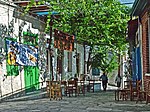


A pergola is most commonly an outdoor garden feature forming a shaded walkway, passageway, or sitting area of vertical posts or pillars that usually support crossbeams and a sturdy open lattice, often upon which woody vines are trained. The origin of the word is the Late Latin pergula, referring to a projecting eave.
It also may be an extension of a building or serve as protection for an open terrace or a link between pavilions. They are different from green tunnels, with a green tunnel being a type of road under a canopy of trees.
Depending on the context, the terms "pergola", "bower", and "arbor" are often used interchangeably. An "arbor" is also regarded as being a wooden bench seat with a roof, usually enclosed by lattice panels forming a framework for climbing plants; in evangelical Christianity, brush arbor revivals occur under such structures. A pergola, on the other hand, is a much larger and more open structure. Normally, a pergola does not include integral seating.
Modern pergola structures can also include architectural or engineering structures having a pergola design, which are not used in gardens. California High-Speed Rail, for instance, uses large concrete pergolas to support high-speed rail guideways which cut over roadways or other rail tracks at shallow angles (unlike bridges or overcrossings which are usually nearly at right angles). (See the high-speed rail pergola structure picture elsewhere in the article for an illustration.)
Description



Features and types
Pergolas may link pavilions or extend from a building's door to an open garden feature such as an isolated terrace or pool. Freestanding pergolas, those not attached to a home or other structure, provide a sitting area that allows for breeze and light sun, but offer protection from the harsh glare of direct sunlight.
Pergolas also give climbing plants a structure on which to grow.
In 1498, Leonardo da Vinci decorated the Sala delle Asse of the Castello Sforzesco in Milan to give the illusion of the great square and vaulted reception hall being within a pergola that was made up of the intertwined branches of sixteen huge mulberry trees. The novel project was commissioned by the Duke of Milan, Ludovico Sforza.
Green tunnels

Pergolas are more permanent architectural features than the green tunnels of late medieval and early Renaissance gardens that often were formed of springy withies—easily replaced shoots of willow or hazel—bound together at the heads to form a series of arches, then loosely woven with long slats on which climbers were grown, to make a passage that was both cool, shaded, and moderately dry in a shower.
At the Medici villa, La Petraia, inner and outer curving segments of such green walks, the forerunners of pergolas, give structure to the pattern that can be viewed from the long terrace above it.
History

Origin
The origin of the word is the Late Latin pergula, referring to a projecting eave. The English term was borrowed from Italian. The term was mentioned in an Italian context in 1645 by John Evelyn at the cloister of Trinità dei Monti in Rome He used the term in an English context in 1654 when, in the company of the fifth Earl of Pembroke, Evelyn watched the coursing of hares from a "pergola" built on the downs near Salisbury for that purpose.
Historical gardens
The clearly artificial nature of the pergola made it fall from favor in the naturalistic gardening styles of the eighteenth and nineteenth centuries. Yet handsome pergolas on brick and stone pillars with powerful cross-beams were a feature of the gardens designed in the late nineteenth and early twentieth centuries by Sir Edwin Lutyens and Gertrude Jekyll and epitomize their trademark of firm structure luxuriantly planted. A particularly extensive pergola is featured at the gardens of The Hill in Hampstead (London), designed by Thomas Mawson for his client W. H. Lever. Pergola in Wrocław was designed in 1911 and became a UNESCO World Heritage Site in 2006.

Modern pergolas



Modern pergola design materials including wood, vinyl, fiberglass, aluminum, and chlorinated polyvinyl chloride (CPVC) rather than brick or stone pillars, are more affordable and are increasing in popularity. Wooden pergolas are made either from a weather-resistant wood, such as western red cedar (Thuja plicata) or, formerly, of coast redwood (Sequoia sempervirens). They are painted, stained, or use wood treated with preservatives for outdoor use. For a low maintenance alternative to wood, the contemporary materials of vinyl, fiberglass, aluminum, and CPVC can be used. These materials do not require yearly paint or stain like a wooden pergola would, and their manufacture can make them even stronger and longer-lasting than a wooden pergola. These contemporary material pergolas can also be motorized to open and close.
See also
References
- "Which Pergola Is Right for You?". Fox News. March 17, 2016. Archived from the original on September 11, 2018. Retrieved September 10, 2018.
- Marberry, Mark (May 2, 2019). "Brush arbor revivals are still around". Daily Journal Online.
- "How To Build A Pergola" on Ron Hazelton's HouseCalls
- Ruggiero, Rocky, Episode 142 – Leonardo da Vinci’s Sala delle Asse, Making Art and History Come to Life, Rebuilding the Renaissance, October 6, 2021
- OED, sub verbo "pergola"; Dictionary.com "pergola"
- Diary and Correspondence of John Evelyn, F.R.S., 22 February 1645.
- Diary and Correspondence of John Evelyn, F.R.S, 20 July 1654.
- "Centennial Hall in Wrocław". UNESCO World Heritage Centre. Retrieved April 22, 2021.
External links
- [REDACTED] Media related to Pergolas at Wikimedia Commons
- [REDACTED] The dictionary definition of pergola at Wiktionary
| Hut dwelling designs and semi-permanent human shelters | ||
|---|---|---|
| Traditional immobile |
|  |
| Traditional mobile | ||
| Open-air | ||
| Modern | ||
| Related topics | ||